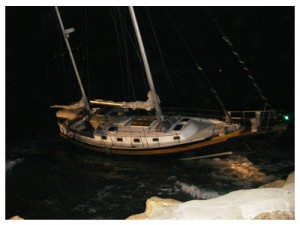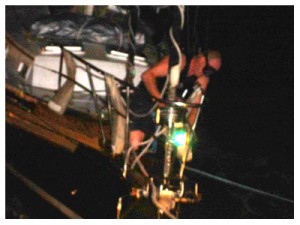40’ sailboat runs aground in the surf outside of Oceanside harbor

40' sailboat aground in Oceanside
June 12, 2009, approx 2200: Vessel Assist San Diego was called to rescue a 40’ sailboat before it broke apart on the south jetty at Oceanside harbor. Captain Tony Olson and his salvage team mobilized their rescue boat, the “Vessel Assist Shelter Island”, adding additional towline and salvage gear before departing San Diego for Oceanside with the intent of saving the sailboat before it was broken apart on the jetty.
Meanwhile, in Escondido Captain Robert Butler, the president of Vessel Assist San Diego, and his crew member, Michael Greer, loaded a 4×4 truck with salvage gear and drove to Oceanside harbor to rendezvous with the “Shelter Island” and her crew. Once on scene Robert met with the owner of the sailboat and informed him that his rescue boat had a 1.25 hour ETA. The owner of the boat was not optimistic that his vessel would be saved but simply asked Robert to “try his best”.
The lifeguards who initially rescued the owner (and one other man) from the sailboat had deployed an anchor, giving the stricken sail boat a slight chance to survive the severe pounding from the surf as it inched closer and closer to the rocks during the one hour and fifteen minute wait for the salvage team.
The “Shelter Island” and it’s crew steamed at 27 knots on a dark moonless night towards Oceanside. As the boat made way, the crew readied the 1200 feet of ½ inch Amsteel blue line that they would use for the job, while salvage diver Shane Thompson readied himself for the dangerous night-swim through the pounding surf and treacherous currents. As the “Vessel Assist Shelter Island” approached the jetty spectators on the rocks and around the beach cheered, however Robert Butler knew that he and his crew only had one shot at saving the grounded sailboat.
Because of the shallow water, Shane had to swim the entire 1200 feet of line to the boat. As he prepared to begin his swim a set of waves pushed the sailboat to within a few feet of certain destruction. The seemingly long 15 minute swim resulted in Shane finally getting the towline to the grounded sailboat. Once at the boat Shane was faced with the daunting task of boarding the sailboat in the pounding surf without getting crushed by the boat as it surged in the waves, while at the same time trying not to let go of the 1200 feet of towline that had the stress of the currents and outgoing tide pulling against it. Like a scene from a Jackie Chan movie, Shane Thompson scaled up the bow of the boat with perfect timing and with his remaining strength, he was able to jump on board. His next big objective was to attach the towline to the boat in a manner that would allow Captain Olson, operating the “Shelter Island”, to pull with maximum horsepower yet not chafe or part the towline.

Salvage diver Shane Thompson aboard the 40' sailboat
The towline was guided through the bow roller, pinned in place, then tied around the anchor windlass and finally, to a bow cleat. Robert ordered his salvage crew to “clutch forward” so that they could maintain a strain on the towline allowing him to examine the “attitude” of the sailboat and how it would react as it was towed from the beach. Cranking the engines up to 1/3 power, the sailboat to rotated and was repositioned away from the rocks. With the tide now one hour past high Robert realized that time was against him. He ordered ½ power and the sailboat surged and bounced around but would not move. He then ordered ¾ power and you could hear the turbo-chargers on the “Shelter Island” kick in, yet there was still very little movement and almost a ¼ mile to go before the sailing vessel would be in deep enough water to float on her own. At this point Robert ordered the “Shelter Island” to go ahead full-power (which is rare when ungrounding boats). This was a dangerous and very advanced maneuver for the “Shelter Island” and her crew because of the “tripping” danger caused by the cross swells (“tripping” is when the tow line angle and the pitch of the salvage vessel could potentially cause her to be pulled from the side and rolled over). Captain Olson’s expert boat handing skills kept the “Shelter Island” safe as he used the full power of his towboat in this awkward and dangerous situation.
The sailboat lunged forward inches at a time as each wave passed under it. About 30 minutes in to the pull there was a loud pop and Robert’s first thought was that their towline my have snapped. He ordered “all-stop” so that he could investigate the situation and found that the bolts holding the anchor windlass had broken but the bow cleat was still holding. He decided that they were at a point of no return and had pulled the vessel far enough away from the rocks to where he was comfortable that if they lost the cleat, they could reattach the towline and wait out the tide for a second pull attempt during daylight hours. Captain Butler ordered a gradual climb back to full power, dragging the sailing vessel over the shoals until she floated off. The small crowd remaining on the beach cheered as the boat disappeared into the darkness.
Once in deep water the salvage crew had to deal with 300’ of chain the 40lb anchor that was previously holding it in place. Due to the urgency of getting the sailboat into the harbor to deal with any potential water coming into the boat they chose to cut the anchor chain. Captain Olson then towed the boat into the safe haven of Oceanside harbor. Once the sailboat was secured at the dock the salvage team was able to get into the cabin and perform a bilge check which confirmed that the boat was not taking on any water and was, considering what it had gone through, no worse for the wear. Butler thought his job was complete until he was informed that the boat yard would probably not be able to accommodate the twin masted sailboat. At this point the owner requested that his boat be towed to The Marine Group boatyard in Chula Vista since that was where he had previously had work done on the boat.
After a cup of coffee for Tony and his crew member Travis Basom, they towed the boat to San Diego without further incident. After the salvage Robert Butler stated, “In my 20 years of commercial salvage this was the closest I have ever seen a boat get to complete destruction and be saved with minutes to spare.”

